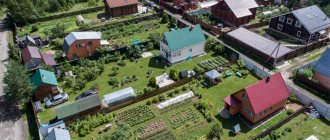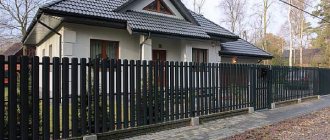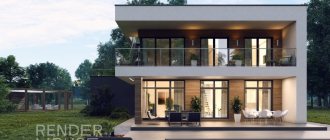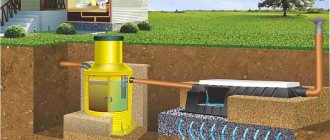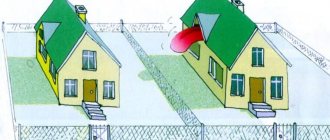SNT or a gardening non-profit partnership has rules and regulations for the development of a site and the location of objects for various purposes. SP 53.13330.2011 replaced the outdated SNiP 30-02-97 - all the main requirements and links to other regulations can be found in this document.
The standards for buildings on a summer cottage in SNT are aimed at ensuring fire and sanitary safety, as well as optimal conditions for growing crops.
Land development in SNT
Do greenhouses need to be registered?
Let's start with perhaps the most pressing issue in the last three months.
As soon as the owners of gardens and vegetable gardens learned about the mandatory registration (and, accordingly, taxes) of outbuildings on a foundation, questions began to pour in about what to do with greenhouses and sheds, toilets, etc. The resonance was so high that at the end of April the deputy chairman of the State Duma Irina Yarovaya asked the head of the Federal Tax Service Mikhail Mishustin to check the information and once again clarify “to pay or not to pay.” Specialists from BTI and Rosreestr responded as follows:
The need to register outbuildings, including greenhouses and sheds, depends on the purpose of the site.
“If the land is intended for vegetable gardening, then the construction of capital construction projects is not allowed on such plots. This means that all outbuildings (sheds, bathhouses, greenhouses, sheds, cellars, wells and other structures) cannot be erected as capital ones - on a solid foundation.
But garden plots can accommodate capital outbuildings that are firmly connected to the ground, that is, objects that cannot be moved without compromising their purpose. Rights to such objects are subject to registration.”
Conclusion: if greenhouses on a permanent foundation appear on garden plots, they will have to be demolished; if on garden plots, they will have to be registered.
Please note that the Russian Ministry of Economic Development is currently developing a bill that clarifies the criteria for classifying objects as immovable or movable things. According to the draft law, auxiliary buildings - sheds, greenhouses, etc. - will be considered improvements to the land plot or the main facility, for example, a residential building. Previously registered buildings can be excluded from the Unified State Register of Real Estate in a simplified manner at the request of the copyright holder.
Sanitary standards and requirements
The requirements for distances from the fence listed earlier also apply to sanitary ones, but they are not the only ones. This also includes standards for the distribution of objects across the site and their distance from each other.
- If the cellar is located outside the residential building, a distance of 12 meters must be maintained from it to the septic tank.
- The norms for the construction of a bathhouse on a garden plot require that it be removed 8 meters from the house.
- The same gap is left from the toilet and composting device to the well. This is necessary so that dirty wastewater is not transferred to drinking water by groundwater (you can find out more about the distance from the house to the septic tank on our website).
Location of buildings on a summer cottage for gardening - basic indentations according to sanitary rules
- A distance of 12 meters is also left from the house to the outbuilding.
- A cellar can be built under the house (the layout of a modern house with a basement is presented in the article) - its maximum height should be 2.2 meters. It is prohibited to allocate space under barns where livestock are kept for a cellar.
Why do they want to extend the dacha amnesty again? How many unregistered dachas are there today?
The dacha amnesty, in fact, ended ahead of schedule on March 1, 2021, when the transition period for the new rules that introduced amendments to the Town Planning Code of August 4, 2021 ended. True, a bill has already been introduced to the State Duma to extend the dacha amnesty until March 1, 2022.
“Neither Rosreestr nor the Cadastral Chamber has such data. Local authorities should have information about how many unregistered individual houses and dachas there are.
Because the Unified State Register of Real Estate (USRN) contains information only about real estate objects registered for cadastral registration and registered rights to them. Since 2006, about 13 million property rights have been registered using a simplified procedure.”
Is it possible to build a residential building on a summer cottage?
Recently, living in a private house has attracted more and more people, becoming one of the most current trends. And it’s not surprising, because your own home opens up many opportunities, from regular exposure to fresh air to distance from neighbors and city noise. However, many questions arise in connection with such a decision.
For example, a person owns a dacha and wants to live permanently on this land. Here the question arises, what kind of house is allowed to be built on a summer cottage and whether such a process is possible in principle. A more global interest cannot be ruled out. For example, which plot is generally better to purchase and whether it is possible to buy land, say, in SNT, for the purpose of building a private house.
In fact, yes, it is possible to build a residential building on such land. But there are some nuances here. And, first of all, it is necessary to remember that now the concept of “dacha” as such has been abolished. Now there are 2 types of land so-called dacha farming. These are gardening and horticultural areas.
The construction of private residential buildings on horticultural lands is permitted. But in garden plots - no. Construction is also permitted on areas allocated for individual construction or individual housing construction.
Moreover, if we are talking about building a house on a garden plot, then it is necessary to remember two conditions:
- A private residential property can be built and registered on a site located near a populated area. Or rather, within its borders. If the land is located outside the city or town, then the construction and registration of an object built on it as a residential one is not permissible.
- When preparing for construction, it is necessary to be guided by the provisions of the town planning regulations. Additionally, there are a number of technical parameters that are mandatory. Failure to comply with regulations can result in significant financial losses.
If the conditions are met, then in principle any house can be built on the dacha territory. Both garden and residential. The difference will be that a small country house is not suitable for permanent residence. But you can live in a full-fledged residential property all year round. In addition, the latter option allows for permanent registration. However, in this case, both the preparatory stage and the construction process itself will require considerable effort.
How long does it take for a citizen to build a house?
The notification nature of construction and registration of real estate, which was introduced by amendments to the Town Planning Code, assumes that a person is given 10 years to build an individual residential or garden house . He must meet this deadline and then submit a notice of completion of construction .
If the building was erected according to the rules, then local authorities themselves submit documents for registration to Rosreestr. With such rules, registration of real estate cannot be avoided, otherwise the object will be considered an unauthorized construction and will be ordered to be demolished.
Conversion of a garden house into a residential building
The procedure for recognizing a garden house as a residential building is regulated by Decree of the Government of the Russian Federation dated January 28, 2006 No. 47 “On approval of the Regulations on the recognition of premises as residential premises...” (as amended on December 24, 2018) (hereinafter referred to as the Regulations).
Requirements for a residential building:
According to Art. 15 Housing Code of the Russian Federation, Art. 4 of the Regulations, residential premises are recognized as isolated premises, which are intended for the residence of citizens, are real estate and are suitable for living, meeting established sanitary and technical rules and regulations, and other legal requirements.
In other words, a residential building must:
- To be built on a foundation, i.e. have a strong connection with the earth;
- Be safe for the life and health of residents;
- Have electricity;
- Be provided with water supply;
- Have a sewerage system (septic tank);
- Be provided with heat supply.
Required documents:
- Application for recognition of a garden house as a residential building.
The application is written in free form with the obligatory indication of the following information:
- Full name of the applicant;
- Postal or email address of the applicant;
- Cadastral number of the land plot;
- Cadastral number of the garden house.
- Method of obtaining a decision from a local government body (in person, by mail, at the MFC).
Sample application:
- Extract from the USRN for a garden house. If the garden house is not registered, then the title document for the house (sale and purchase agreement, certificate of inheritance, etc.). Providing an extract is not mandatory.
- Conclusion on the inspection of the technical condition of the object. This document is the basis for making a decision on converting a garden house into a residential one. The conclusion is prepared by a specialized organization or individual entrepreneur that is a member of the SRO in the field of engineering surveys. An example of such a conclusion:
- If the garden house is under mortgage, then the notarized consent of the mortgagee (bank) to re-register the house is required.
Submission of documents to the Administration.
Documents are submitted in person to the Administration or through the MFC. In response, the Administration or MFC specialist issues the applicant a receipt for receipt of documents.
The application review period is 45 calendar days.
Upon expiration of the specified period, the Administration makes one of two decisions:
- on recognition of a garden house as a residential building;
- on refusal to recognize a garden house as a residential building.
In case of refusal, the Administration is obliged to refer in its decision to one of the following grounds for refusal:
- The application does not contain mandatory information (postal address, cadastral numbers);
- There is no conclusion on the inspection of the object;
- The applicant is not the owner of the garden house;
- The Unified State Register of Real Estate does not contain information about rights to a garden house;
- The consent of the mortgagee (bank) has not been submitted;
- The types of permitted use of the land do not include the placement of a house.
An applicant who does not agree with the decision to refuse has the right to appeal it in court within 3 months.
Is it possible to build two houses on one plot? Or will one have to be demolished?
Theoretically, it is possible to build two houses on one plot of land.
But only in compliance with the norms of land and town planning legislation, building codes and regulations, in particular, the area of the land plot should allow such construction. If “the land plot does not physically allow the construction of a second residential building on it, since the necessary setbacks from the boundaries and other norms and rules (for example, fire safety) are not observed,” then one of the houses will be recommended to be demolished. But you can try to recognize the right to a second home in court.”
Permission to build a residential building
A special document that allows the developer to carry out reconstruction and construction of permanent buildings is called a building permit.
Based on the Town Planning Code of the Russian Federation (subclause 1, clause 17), it is not required for construction on garden plots.
In order to avoid problems with neighbors during the construction of objects, it is necessary to take into account the rules for the location of buildings from borders, roads, and other objects according to SNiPs.
If it is planned to build an object, subsequently registered as an individual residential property, then the owner can obtain permission in a simplified manner in accordance with the Town Planning Code of the Russian Federation (Part 9, Article 51).
To do this, he needs to contact the body authorized in the field of urban planning and submit the following documents:
- of a legal nature,
- urban plan,
- plot layout diagram with the designated location of the facility under construction.
The obtained permission will be submitted to the court.
Can land be seized from the owner?
Yes . The Land Code contains a provision on the termination of the right to a land plot. If a land plot granted with the right of permanent (indefinite) use or lifelong inheritable possession is not used for 3 years, then it may be seized .
A plot can also be confiscated if the land is not used for its intended purpose. For example, a site is allocated for agriculture, and a store is built there, or an activity organized on the site is harmful to the environment (for example, a car wash operates).
Legal norms for the use of garden land
In accordance with the modern classification, there are 2 types of permitted use of land related to gardening:
- Type 1.5 involves conducting activities for the industrial cultivation of perennial crops.
- Type 13.2, in addition to agricultural activities, allows the construction of outbuildings and a garden house on the site.
Thus, only owners of plots with VRI 13.2 “Gardening” .
The category of land is also important: it is better if the plot is located on the territory of populated areas.
Additional information on garden plots located within the boundaries of populated areas can be obtained here.
If the category of land on the gardening plot is agricultural, then it will be very difficult to register there; only a garden house for recreation is allowed to be built there.
Detailed information can be found in the feature article.
Last step
You receive a decision, and you do not need to go anywhere with it: the authorized local government body will send it to the relevant services that make changes to the Unified State Register. This must happen within 15 calendar days. You, of course, can check this point - you also have the right to contact the rights registration authority. But you are absolutely not obligated to do this.
In total, approximately 2-3 months pass from the time you receive the decision to convert a garden house into a residential one. It will take up to 3 weeks to prepare a technical report (this will depend on the efficiency of the engineers you hire); during this time you will need to collect a package of documents and prepare an application. You will need to wait up to 45 days for local authorities to consider the application, another 3 days for it to reach you, and another 15 days for final manipulations in the Unified State Register of Real Estate.
PS A little over a month ago, the Ministry of Construction proposed to transfer the service of recognizing a garden house as residential to electronic rails. If these amendments to the procedure are ultimately adopted, then, at the request of the applicant, the acts and conclusions will be issued in electronic format, which means that perhaps less time will be spent on the procedure.
Lyudmila Gubaeva
Real Estate Tatarstan
Briefly about the main thing
The weekly project “Digital SNT of the Moscow Region” continues to air. The latest issue explained the new rules for planning and developing garden plots.
In particular, it was determined what kind of fencing should be around the perimeter of the site - a mesh fence with a height of at least 1.2 m and no more than 1.8 m. Another type of fence must be agreed upon with the neighbors and the SNT Board.
A complete list of all standards is contained in the Code of Rules SP 53.13330.2019
Source of news – website mobti.ru
Ratings 0
Background
Code of Rules SP 53.13330.2019, which entered into force on April 15, “Planning and development of the territory where citizens conduct gardening. Buildings and Structures” replaced the document of 1998, when it was still impossible to register in the SNT and there was a designation of land “for dacha construction”.
During the 7th online meeting with gardeners and summer residents, which take place within the framework of the Digital SNT of the Moscow Region project, representatives of the Ministry of Property Relations of the Moscow Region, the Union of Summer Residents of the Moscow Region and the Moscow Regional BTI spoke about the new standards and requirements of the new set of rules.
